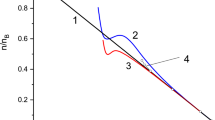Abstract
The generalization of the virial theorem is discussed. The case where the potential energy is a sum of homogeneous functions of various degree is investigated. If the potential energy U is composed of a gravitational (or Coulomb) energy and an energy of the short-range repulsion of particles, then virial inequalities of the form 2¯K + Ū < 0 are valid, where K is the kinetic energy. For classical systems of this type, but with a Hamiltonian relativistic in the momenta, the inequality 3Nθ < ¦Ū¦ holds, where N is the number of particles in the system, θ = kT, T is the temperature, and k is Boltzmann's constant.
Similar content being viewed by others
Literature cited
Ya. P. Terletskii, Statistical Physics [in Russian], Vysshaya Shkola, Moscow (1973), pp. 87–90.
A. S. Davydov, Quantum Mechanics, Pergamon (1965).
S. Chandrasekhar, Introduction to the Study of Stellar Structure, Dover, New York (1958).
Author information
Authors and Affiliations
Additional information
Translated from Izvestiya Vysshikh Uchebnykh Zavedenii, Fizika, No. 6, pp. 76–79, June, 1979.
Rights and permissions
About this article
Cite this article
Terletskii, Y.P. Quantum and relativistic virial inequalities. Soviet Physics Journal 22, 632–635 (1979). https://doi.org/10.1007/BF00891557
Received:
Issue Date:
DOI: https://doi.org/10.1007/BF00891557



